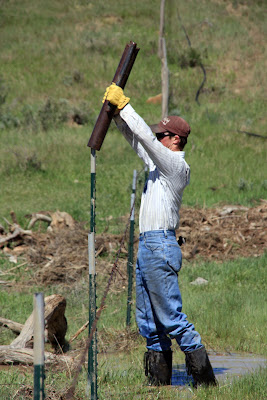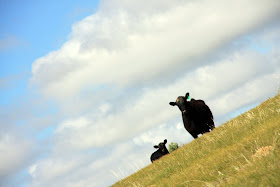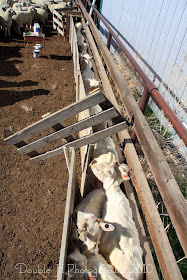With rain comes floods where I'm from. With floods comes fence to fix. A water-gap is where water flows under a fence. There typically isn't any running water where I'm from, but it's been a wet spring, so there has been lots of water and lots of fence to fix as a result.
 Here's the water-gap upon arrival. This really isn't a true water-gap, but it will work to demonstrate the procedure. Lots of logs and junk hangs up on the fence and breaks the wires and bends the posts. We use steal posts on this one because this happens relatively often and they're easier to work with in this situation.
Here's the water-gap upon arrival. This really isn't a true water-gap, but it will work to demonstrate the procedure. Lots of logs and junk hangs up on the fence and breaks the wires and bends the posts. We use steal posts on this one because this happens relatively often and they're easier to work with in this situation. Everything that's gathered on the fence has to be removed. All the dirt and dead grass can cake into a type of cement if left too long and be a real pain. The pitchfork helps remove the debris. A couple years ago several severe floods caught rabbits and would bury them in this mixture. When your fixing fence and it's hot and humid and you uncover a week-old rabbit it's not pretty. You will, at the very least, gag.
Everything that's gathered on the fence has to be removed. All the dirt and dead grass can cake into a type of cement if left too long and be a real pain. The pitchfork helps remove the debris. A couple years ago several severe floods caught rabbits and would bury them in this mixture. When your fixing fence and it's hot and humid and you uncover a week-old rabbit it's not pretty. You will, at the very least, gag.Floods will also take broken wires and wrap them around sagebrush, logs and other misc. items downstream. You get to unwind, untangle and gather it all up because if you don't a cow or horse can cut their leg on it. The cement mixture can build up around the wires until they're several inches in diameter too. Floods are a bit of a nuisance
 You throw everything downstream of the fence so it doesn't just wash right back into it during the next flood. Holly helped with smaller sticks. Some of the larger logs have to be drug with a 4-wheeler and chain in some cases.
You throw everything downstream of the fence so it doesn't just wash right back into it during the next flood. Holly helped with smaller sticks. Some of the larger logs have to be drug with a 4-wheeler and chain in some cases. The pitchfork, in action.
The pitchfork, in action. Then we unclip any wires still attached to the posts. This guy is my "little" brother. He's single, tall, hard working and likes guns-just a little sisterly help there. Anyway, back on subject-another thing to point out at this time is I was actually helping and would just grab my camera periodically to snap the process. I also discovered a crack in the bottom of my mud boots on this morning and could be seen hopping through the deeper puddles in an effort to keep my foot dry-it didn't work.
Then we unclip any wires still attached to the posts. This guy is my "little" brother. He's single, tall, hard working and likes guns-just a little sisterly help there. Anyway, back on subject-another thing to point out at this time is I was actually helping and would just grab my camera periodically to snap the process. I also discovered a crack in the bottom of my mud boots on this morning and could be seen hopping through the deeper puddles in an effort to keep my foot dry-it didn't work. Next we pull the posts so we can reset them in a more upright, useful position. This is easy with the ground so soft, but you can't just walk up and jerk one of these out the ground on any given day.
Next we pull the posts so we can reset them in a more upright, useful position. This is easy with the ground so soft, but you can't just walk up and jerk one of these out the ground on any given day. Each wire is stretched using the stretchers. Forgive the blurriness here, but it was the best photo I had of the stretchers. The fence stretcher grips the wire on two ends and you ratchet them together. The two ends are then tied together using a very specific "knot" and the stretchers are released to remove the tension, then the wire is removed from each end and you go on to the next wire.
Each wire is stretched using the stretchers. Forgive the blurriness here, but it was the best photo I had of the stretchers. The fence stretcher grips the wire on two ends and you ratchet them together. The two ends are then tied together using a very specific "knot" and the stretchers are released to remove the tension, then the wire is removed from each end and you go on to the next wire. After stretching the top wire we set our posts, using it as a guide of where they need to be. If you stretch all 4 or 5 wires before setting your posts it makes this step harder. The thing he is using to pound the posts is called a post pounder (someone really gave that one thought, I know). It is HEAVY. I mentioned being buff at the end of the summer and this has a lot to do with. I'm guessing its weight at around 50 pounds and we pack it around when building fence and some days pound many many posts.
After stretching the top wire we set our posts, using it as a guide of where they need to be. If you stretch all 4 or 5 wires before setting your posts it makes this step harder. The thing he is using to pound the posts is called a post pounder (someone really gave that one thought, I know). It is HEAVY. I mentioned being buff at the end of the summer and this has a lot to do with. I'm guessing its weight at around 50 pounds and we pack it around when building fence and some days pound many many posts. I would recommend you add that into your exercise program for a core and total upper body workout. Packing it up and down hills when the temp is in the 90s would count as a total body workout too.
 Once the post is lined up and the pounder is on it, you just go up.....
Once the post is lined up and the pounder is on it, you just go up..... and THUNK, down. Please repeat until post is at desired height (which is a point between my hip bone and rib bones and at about his hip bone). Again, this takes about two THUNKS when the ground is so wet, but when it's dry and hot out you have to put more effort into it. Think lots of sweat and feeling like you really did something at the end of the, fencing will get you there.
and THUNK, down. Please repeat until post is at desired height (which is a point between my hip bone and rib bones and at about his hip bone). Again, this takes about two THUNKS when the ground is so wet, but when it's dry and hot out you have to put more effort into it. Think lots of sweat and feeling like you really did something at the end of the, fencing will get you there. Then we stretch the remaining wires and re-clip each wire at a specific height on the post. Kyle took this of me, I had to show you I did something. Emmie and Pearl were on-site as well (probably hoping for a week-old rabbit)
Then we stretch the remaining wires and re-clip each wire at a specific height on the post. Kyle took this of me, I had to show you I did something. Emmie and Pearl were on-site as well (probably hoping for a week-old rabbit) You can see the post has "bumps" that hold the wire at a certain level. Each wire is spaced by a set number of "bumps" This kind of post is called a T-post. If you look straight down on the top of one it is shaped like a T. We also use wood posts and I know based on points on my hip, thigh, knee, calf and ankle where each wire should be stapled onto those posts. The piece of bright silver wire was added when Kyle was stretching and the "knot" (I just don't know what else to call it, but it's not really a knot) can be seen at either end.
You can see the post has "bumps" that hold the wire at a certain level. Each wire is spaced by a set number of "bumps" This kind of post is called a T-post. If you look straight down on the top of one it is shaped like a T. We also use wood posts and I know based on points on my hip, thigh, knee, calf and ankle where each wire should be stapled onto those posts. The piece of bright silver wire was added when Kyle was stretching and the "knot" (I just don't know what else to call it, but it's not really a knot) can be seen at either end. And we're done, with the first one. This is an easy one to fix because:
And we're done, with the first one. This is an easy one to fix because:A) It's right next to the country road, most water-gaps are well off the beaten path and take forever to get to
B) We can use T-posts and they're easy to jerk out of the soft ground and reset
C) This is a nice, flat area. Most water-gaps are in the bottom of steep draws or creeks and you have to be creative sometimes to find a solution that will keep livestock from walking right over or under the fence
D)Kyle and I did it together and we work great together. We rarely have to say anything about the job because we've been doing this with each other for 15+ years. Holly helped too, which was great.
 On to the next one!
On to the next one!












































